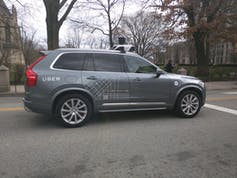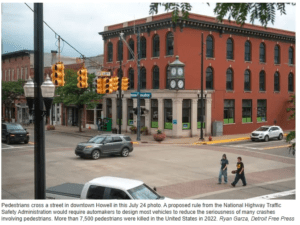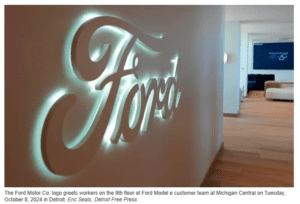Self-driving cars are coming – but are we ready?

It’s been 60 years since the cover of Popular Mechanics magazine gave us the promise of flying cars. But our personal mobility options remain, today and for the foreseeable future, earthbound. Will the promise of self-driving cars be as elusive? In short, no. The dream of taking a road trip in which we pay more attention to a new book or movie than we do to the driving task is well within reach.
Sixty years ago, flying cars captured Americans’ imagination. Can we get self-driving cars sooner?
Popular Mechanics
Still, we’re not there yet. And people are just beginning to ask a very important question: How might our nation’s roads and highways, and the driving done by we humans ourselves, need to change as autonomous vehicles become more ubiquitous? As researchers at the Texas A&M Transportation Institute who study many of the implications of self-driving cars, we find the answer in two important sets of realities – those we know, and those we don’t know.
Starting slowly, and in cities
For starters, we know that self-driving cars won’t become commonplace overnight. The vast majority of cars on the road now have no automation features or only very limited automation, like cruise control. You can find a few self-driving cars being tested on public roads now if you know where to look. But you won’t likely find many in a dealer showroom for at least 10 years.
Another factor that will further delay the widespread use of autonomous cars is that many people hang on to their cars as long as possible. The number of highly automated cars as a share of everything on the road will grow over time, but only relatively slowly.

A self-driving Uber car on the road in Pittsburgh.
Jeff Inglis, The Conversation, CC BY-ND
In addition, we can be quite confident that autonomous cars will appear on city streets before they make it to the interstate highways. The reasons have more to do with public policy than they do with technology. Local governments are typically more nimble than state and federal agencies, which is one reason why you can find robotic taxis being tested right now on the streets of Pittsburgh, Phoenix and San Francisco.
Interstate highway operations and safety rules are governed by state and federal laws and regulations, which are much more complex. For the most part, self-driving cars will be ready for the open road long before the open road is ready for them.
Another factor delaying the widespread use of self-driving cars is money. The transformations that will support autonomous travel won’t be cheap. That’s true for the private companies designing and building self-driving cars, and for the taxpayer-funded government agencies that design and build the roads on which they’ll drive. Ensuring cars can communicate with each other will require industry investment; their ability to converse with roads, pavement markings, road signs and traffic signals will need government support.
Yet some states already are short of money they need to repair existing roads and bridges, much less build new ones or add technology to the mix. The certainly high price tag raises vexing questions about our current (and likely outdated) funding system.
Many questions remain
That gives us a good start when imagining what could be possible in a world with more autonomous cars on the road. But there is still a lot we don’t know.
Some unknowns are fairly technical. How well will autonomous vehicles operate in rain or snow? And how will they handle changing conditions on unpaved roads, which make up nearly half of the country’s 4 million miles of road?
Other unknowns are more about the transportation system as a whole. Will self-driving cars help to ease traffic congestion, or make it worse? Without a lot of autonomous cars in the world to test or experiment with, we’re left to rely on computer modeling to aid our search for answers. To say that modeling the effects of these vehicles in a real-world setting is complex is putting it lightly; making allowances for unpredictable human behavior in that modeling only compounds the complexity. For now, any argument that self-driving cars will be an antidote for congestion may be, at best, uninformed and specious.
Will self-driving cars make our roadways dramatically safer? Most crashes result from human error, so it seems logical to assume that removing humans from the process reduces the likelihood of a crash. We’re long on hopes here, but so far short on evidence, especially about what might happen during the transition period when both self-driving and conventional vehicles are sharing the roads. There is reason for cautious optimism, because federal agencies do have preliminary data suggesting that the safety performance of some self-driving cars is better than national human-driving averages.
We don’t know whether car ownership trends will change. People might want their own personal self-driving auto, or maybe they’ll just want to call a robotaxi whenever they need a ride. TTI research showed that respondents in one Texas city were evenly split, 50-50, on whether they’d ever travel in a self-driving car. We expect that as people experience more automation in their cars and become knowledgeable about potential safety and other benefits, acceptance and likely adoption will increase. It’s unclear how people will spend their time in a car that drives itself and how that might influence other travel-related decisions, including decisions about traveling more, or less.
What drivers will need to know will have to change, too, in ways that aren’t entirely clear. We’ll have to adapt driver education programs and tests to ensure people understand how to operate self-driving vehicles safely. We’ll all need to know about humans’ roles in emergency procedures, maintenance tasks or other new elements of autonomous driving.
And what about liability? If a car with no driver is involved in a crash (yes, that happened), who’s at fault? If a car with no driver is stopped by a police officer for driving too slowly (yes, that happened, too),
to whom should the citation be issued? For the time being, the onus is on the human driver who must remain alert and be ready to take over vehicle operations.
This list of queries is merely a start. As with any emerging research and development venture, unforeseen issues and new questions will arise. Put another way, we don’t yet fully know what we don’t know.
What is certain is that we’re experiencing the most pivotal time in transportation history since we started building interstate highways. Our cars won’t be able to fly, but they will be much more capable than we’re used to. They’re not quite ready yet – and we’re not either – but it won’t be long. We can expect it to be an eventful ride, no matter who’s in the driver’s seat.






